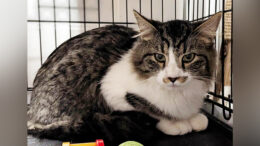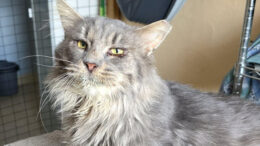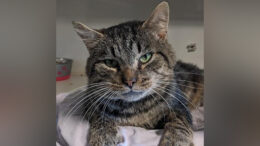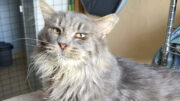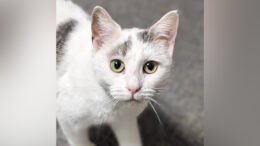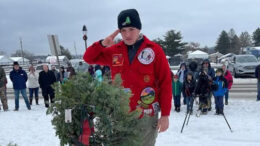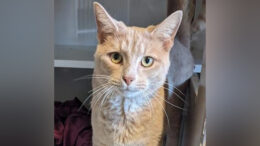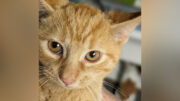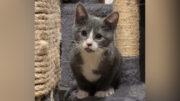Well, the good news is it’s not broken.
That’s basically the diagnosis Dr. Nicole Palumbo of the Franklin Animal Clinic was able to give Maryjane Angelo of Skye’s Spirit Wildlife Rehabilitation Center in Harrisville when she took an injured bald eagle in for X-rays on Wednesday.
Forest County wildlife conservation officer Daniel Schmidt found the hurt bird along the edge of the road near German Hill in Tionesta.
Angelo said the center had received a message on its machine about the bird, but that the caller left no callback information.
It turns out the Game Commission had also received calls and was out looking for the eagle, Angelo said.
Angelo said she was pleasantly surprised that were no fractures.
She said, in her 17 years of rehabbing, when a bird’s feathers are twisted like that it usually indicates a broken wing or other more severe trauma.
“Those feathers are a couple of feet long and are very stiff,” Angelo said.
When they get twisted like that they just don’t go right back into place, she said.
Angelo guessed that the eagle could have possibly been rolled by a car or have gotten into a fight with another eagle.
She said, “We’ll never know,” because the eagle isn’t talking.
Angelo estimated the eagle’s age to be near or more than 5 years old. She said eagles don’t get their full white head and tail until they are 5 years of age.
After that, it is difficult to guess their age unless the bird has been banded, she said.
The eagle now sports a bright pink bandage around his wing, which he will be wearing for a week or two, Angelo said.
The wrapping will provide some support for the wing until it goes back into place, she added.
The bird was placed on an approved pain reliever and anti-inflammatory medication for a few days, Angelo said.
She said the eagle was underweight due to its inability to fly. She speculated he could only get the food he was able to scavenge for.
She said he was a little more than 6 pounds when he arrived and that a healthy weight for a bird of that size should be about 8 to 12 pounds.
He will enjoy meals fit for our national symbol – frozen rodents and fish.
Angelo said she will vary his diet from day to day as the eagle wouldn’t be eating the exact same meal every day in the wild.
She estimated it would take a month or two to get the eagle back up to a healthy weight. She said the process would take time, as going too fast could actually make the eagle sick.
After he’s back up to a healthy weight, it will be off to various flight enclosures at the center for the eagle, according to Angelo.
He’ll start off in a small enclosure and then get moved to the larger enclosure where he can fully stretch his wings, she said.
Then when the time is right, “He’ll go right back to where he was found,” Angelo said.
She added he may have a mate or nest in the Tionesta area to return to.
In the event that a bird can’t be released into the wild, the center tries to find placement for it in an educational setting such as zoos or other facilities, Angelo said.
Angelo said she has to been state and federally licensed to care for eagles and that the vet signed to her permit is Palumbo.
“She’s fantastic,” Angelo said of Palumbo and that Palumbo is very experienced with birds of prey.
It all adds up
Angelo and her husband, Robert, have operated Skye’s Spirit since 1998. The center is a registered non-profit.
The center is not state or federally funded and relies on donations to operate.
Costs can quickly mount with feed bills and medical costs.
Angelo estimated the eagle’s feeding cost at $10 to $15 a day. And since he is expected to stay for a few months, the bills can quickly add up and that doesn’t even include the eagle’s medical costs.
Donations can be made to Skye’s Spirit Wildlife Rehabilitation Center, 889 Farren Surrena Road, Harrisville, 16038. People can donate online at www.skyes-spirit.com.
Busy baby season
Meanwhile, in addition to caring for the eagle the Angelos have their hands full caring for many new spring arrivals.
Maryjane Angelo said she’s rehabbing several young squirrels and fully expected to be inundated in the coming weeks with baby birds, rabbits, opossums and fawns.
The center takes most animals with the exception of raccoons, skunks, coyotes, foxes and groundhogs. These animals are considered rabies vector species and the center is not permitted to take them.
Angelo said the best thing to do for young animals – if they are not injured – is to leave them alone.
For baby birds whose nest maybe displaced, she advised placing the nest back into the crook of a tree.
She said it is an old wives’ tale that animal mothers will not return if their young has been handled by a human.
“Human scent is everywhere,” she said. “The young will not abandoned by us touching them.”
The center’s answering message gives advice to those who may find themselves in need of its services. It advised callers to wear gloves and place the animals in a box until they can be transported. The center can be reached by calling (814) 786-9677.
Angelo advised people against trying to feed the animals until they can get them to the center.
She said most times well-meaning intentions can actually make the problem worse for the animals.
Angelo said the important thing is to get the animals to the center so they can get the proper treatment, but that people must schedule a time to arrive at the center with animals.
And what does Angelo get from all of her animal-helping efforts.
“Not even a thank you,” she said with a laugh. “When they’re released, they don’t even look back.”




